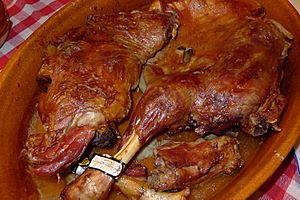Lechazo de Castilla y León facts for kids

Lechazo de Castilla y León is a special type of lamb meat from Castile and León, a region in Spain. It's known as a "protected-origin food product" in Europe. This means it has to be produced in a certain way and in a specific area to get this name.
The lambs used for Lechazo are very young. They are fed only their mother's milk. This makes the meat very tender and flavorful. People in Castile and León love this meat. Roast lamb and lamb chops are popular dishes in restaurants there.
What is a Lechazo?
The word lechazo in Spanish means a young sheep that is still drinking its mother's milk. For the meat to be called Lechazo de Castilla y León, the lambs must come from specific types of sheep. These include the Churra, Castellana, or Ojalada breeds.
Rules for Lechazo Meat
To make sure the meat is always top quality, there are strict rules. These rules are set by a group called the Indicación Geográfica Protegida (I.G.P.) Council. Their main office is in Zamora, Spain.
Here are some of the rules for the lambs:
- They must weigh between 9 and 12 kilograms (about 20 to 26 pounds) when they are ready.
- They must be no older than 35 days.
The I.G.P. started in 1997. Today, over 480 farms in Castile and León follow these rules. They produce more than 167,000 lechazos every year!
See also
 In Spanish: Lechazo de Castilla y León para niños
In Spanish: Lechazo de Castilla y León para niños

